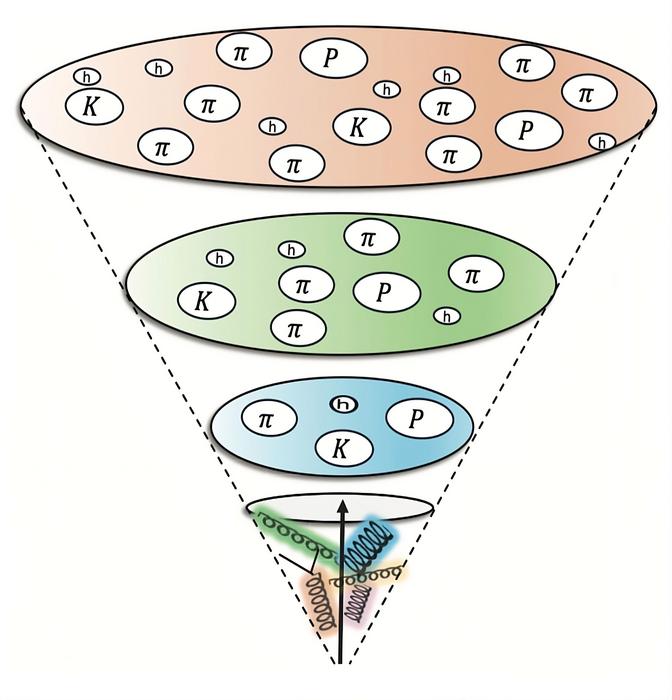Physicists at the U.S. Department of Energy’s Brookhaven National Laboratory, in collaboration with researchers from Stony Brook University, have made significant strides in understanding the intricate relationships between quantum entanglement and particle formation in high-energy collisions. Their groundbreaking study, recently published as an Editor’s Suggestion in Physical Review Letters, sheds light on the complex processes taking place during proton-proton collisions. The findings reveal a remarkable connection between a jet’s initial conditions and the distribution of particles that emerge as the jet undergoes evolution.
The core of this investigation revolves around collimated sprays of particles known as jets, which are produced when quarks or gluons are freed in intense environments—like those created during high-energy proton collisions. These jets serve as valuable tools for physicists seeking to decode the mysteries inherent to particle physics. Prior research has hinted that the structure and behavior of these jets contain vital clues regarding their origins. However, the explicit link between the states of these high-energy particles at the onset of jet formation and the final products observed has eluded scientists until now.
In their recent study, the research team, led by Charles Joseph Naim, focused on a fundamental aspect of quantum mechanics: entanglement. Entanglement refers to a peculiar quantum phenomenon where the properties of one particle become interconnected with those of another, regardless of the distance separating them. This study is revolutionary because it establishes a direct relationship between the concept of entanglement entropy and the particles produced in jets. This connection implies that the initial quantum state of the system can provide insights into the eventual particle distribution observed in collision experiments.
The research was driven by a desire to explore how the entanglement among quarks and gluons affects the subsequent arrangement of particles in jets. Abhay Deshpande, a distinguished professor at Stony Brook University and a co-author of the study, expressed the need to understand whether the distribution of hadrons within these jets could be influenced by the level of entanglement present among the constituent quarks and gluons during jet formation. By connected theory with empirical data, the study begins to unravel the complexities surrounding this phenomenon.
The findings are rooted in an analysis of data acquired from the Large Hadron Collider’s ATLAS experiment, where scientists observed jets formed as a result of proton-proton collisions. Within these intense collisions, protons are broken apart, scattering quarks and gluons that subsequently recombine through a process known as fragmentation. This process leads to the emergence of hadrons—stable composite particles that include protons and mesons such as pions and kaons. The research team hypothesized that jets formed under conditions of maximal entanglement would exhibit a particular entropy structure, leading to a unique distribution of hadrons.
Indeed, as they delved into the data, the scientists discovered that the hadron distributions aligned closely with their predictions. This empirical evidence of maximal entanglement was profound, indicating that the jets formed during high-energy collisions retained crucial information about their genesis. The implications of this research extend beyond theoretical interest; they open avenues for future experiments that could provide further insight into how entanglement influences hadron formation and behavior in different collision scenarios.
One of the most exciting aspects of this study lies in its applicability to upcoming experiments at the Electron-Ion Collider (EIC), which is poised to be a next-generation facility for nuclear physics research. The EIC will facilitate unprecedented precision measurements of jets formed in both electron-proton and electron-nucleus collisions, allowing researchers to investigate how quantum entanglement operates across different systems. Such exploration promises to refine our understanding of various essential concepts within particle physics, including the extent of quantum effects in nuclear particles.
As scientists continue to sift through the implications of their study, they also highlight how these findings contribute to a broader understanding of hadronic matter’s fundamental nature. The notion that quarks and gluons can exhibit varying states of entanglement that influence the distribution of resultant particles emphasizes an inherent complexity that challenges conventional understandings of particle dynamics. It also serves to illustrate the intricate balance of order and disorder that emerges within high-energy particle interactions.
The pioneering nature of this research does not solely come from its results but also from its potential to stimulate further inquiry into quantum entanglement’s role in subatomic processes. This study is a testament to the remarkable interplay between fundamental physics principles and technological advancements in experimental facilities like the LHC and EIC. As developments in quantum information science and experimental techniques progress, the prospect of understanding entanglement in ever greater detail becomes increasingly feasible, providing pathways to future discoveries.
In conclusion, the work conducted by physicists at Brookhaven National Laboratory and Stony Brook University marks a significant milestone in our understanding of quantum entanglement’s role in hadronization and jet formation. By bridging theoretical concepts with empirical data, this collaborative endeavor illustrates the potential of quantum mechanics to shape our comprehension of the universe at fundamental levels. The resulting insights could redefine approaches in particle physics and inspire further research that continues to push the envelope of what we know about the fabric of existence.
As our inquiries into the quantum realm deepen, we stand at the precipice of a new era in understanding. There lies an exciting potential to discover new phenomena that redefine our expectations and redefine elementary subatomic theories. The study of entanglement as a probe into hadronization not only invites greater exploration but also serves as a guiding light into the uncharted territories of quantum physics, propelling the scientific community forward.
Subject of Research: Quantum Entanglement and Particle Formation
Article Title: Entanglement as a Probe of Hadronization
News Publication Date: 19-Mar-2025
Web References: Physical Review Letters, Brookhaven National Laboratory
References: DOI: 10.1103/PhysRevLett.134.111902
Image Credits: Charles Joseph Naim/Stony Brook University
Keywords: Quantum mechanics, Quantum entanglement, Particle physics, Hadrons, Quarks, Quantum information science, Nuclear physics, Electron-Ion Collider.




